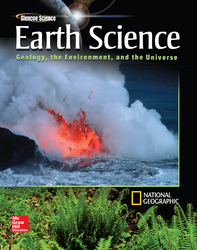1 A) Gondwanaland B) Pangaea C) North America D) Laurasia 2 A) plowing through oceanic crust B) formed at deep ocean trenches C) slowly sinking into the ocean floor D) floating on top of oceanic crust 3 A) sinking magma B) rising magma C) earthquakes D) drifting continental crust 4 A) shallow-sea trenches and volcanic islands B) volcanic islands and mid-ocean ridges C) mid-ocean ridges and earthquakes D) mid-ocean ridges and deep-sea trenches 5 A) magnetometer B) paleogeography C) paleomagnetism D) paleontology 6 A) younger than B) a different composition than C) older than D) the same age as 7 A) an isochron B) a magnetic reversal C) a normal polarity D) a reverse polarity 8 <a onClick="window.open('/olcweb/cgi/pluginpop.cgi?it=gif::::/sites/dl/free/0078746361/561688/129_age_ls_170c.gif','popWin', 'width=NaN,height=NaN,resizable,scrollbars');" href="#"><img valign="absmiddle" height="16" width="16" border="0" src="/olcweb/styles/shared/linkicons/image.gif"> (12.0K)</a> A) nonexistent B) reversed C) normal D) half-reversed 9 A) at mid-ocean ridges B) in deep-sea trenches C) at plate centers D) at plate boundaries 10 A) convergent boundary B) mid-ocean ridge C) transform boundary D) divergent boundary 11 A) theory of plate tectonics B) hypothesis of continental movement C) theory of seafloor spreading D) hypothesis of continental drift 12 <a onClick="window.open('/olcweb/cgi/pluginpop.cgi?it=jpg::::/sites/dl/free/0078746361/561661/133_plateconn_ls_172c.jpg','popWin', 'width=NaN,height=NaN,resizable,scrollbars');" href="#"><img valign="absmiddle" height="16" width="16" border="0" src="/olcweb/styles/shared/linkicons/image.gif"> (35.0K)</a> A) near the south pole B) in the middle of the Pacific Ocean C) in northern Eurasia D) along the west coast of North America 13 A) ultraviolet radiation absorbed by rocks B) the decay of radioactive elements C) lightning strikes D) rotation of Earth's core 14 A) silica B) iron C) calcium D) magnesium 15 A) at the mid-ocean ridges B) along the continental shelves C) in the Mariana Trench D) near the Hawaiian Islands





